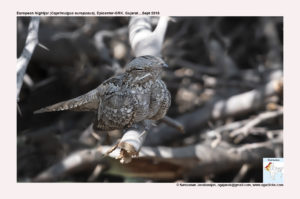
European Nightjar Caprimulgus europaeus
Etymology:
- Caprimulgus : Latin word capra – goat; mulgere –to milk . The nightjar were assumed to drink goats milk and injure the goats
- Europaeus: From Europe
Vernacular Names:Pakistan: Patak, Pun: Chapaki, Guj: Pardeshichhapo, Shiyaludasharadhiyu, Mar: European Ratwa
Distribution in India: Passage migrant in North West India.
Description: Size of 24·5–28 cm; weight of male is 51–101 g, weight of female is 67–95 g. They are sexually dimorphic. The upperparts are greyish-brown streaked blackish-brown with indistinct pale buff nuchal collar; lesser coverts are brown, rest of wing-coverts are greyish-brown spotted buffish, showing buff line across fore-wing and buff line along scapulars; broad buffish-white submoustachial stripe and white throat patch. The underparts are greyish-brown, barred brown and spotted buff, becoming buff barred brown on belly and flanks. The male has white spot on three outermost primaries and white tips to two outermost tail feathers, female lacking white markings.The Iris is dark brown, bill is blackish, legs and feet are brown or flesh-brown.
Habitat:It is found in dry, open country: lowland heaths with scattered trees and bushes, commons and moorland, forest and woodland, recently felled woodland and young forestry plantations. Also found in chalk downland, industrial waste tips, wooded or scrub-covered steppe, sparsely forested or stony hillsides, oak scrubland, dense coppices steppes, treeless plains, dense forest interior, mature plantations, cultivation and tall grassland, but not infrequently forages over such areas as farmland, gardens, reedbeds and wet habitats. On wintering grounds it is found in wooded country, dry coastal acacia steppe, forest clearings, open sandy country and highlands. It is recorded from sea-level to 2800 m on breeding grounds and up to 5000 m during winter.
Food habits: It eats beetles, mantises, mayflies, dragonflies, Orthoptera, cockroaches, bugs, Hymenoptera, antlions, lacewings, caddisflies and flies. It also eats butterflies and flightless glow-worms, and also feeds on spiders and mites. Grit and small stones are also ingested and vegetable matter is probably taken accidentally. The foraging flight is agile and buoyant. It hunts over open country, in clearings, along woodland edges and borders, in woodland glades and rides, in gardens and orchards, over wetlands, in meadows and farmland, around grazing animals, and over stagnant ponds. It also feeds on insects at artificial lights. It may forage diurnally on overcast days. Also makes short flycatching sallies from ground or low perches, and hovers close to vegetation to take food from foliage. Occasionally hovers and swoops down after prey. Rarely feeds on ground, but does so by darting forward to take prey. It drinks in flight.
Breeding habits: They breed May to Aug, occasionally Apr–Jul in some regions; breeding often influenced by lunar phase. They are generally monogamous and territorial. The nest-site is in open, beneath tree, bush or shrub, within upturned tree roots or among vegetation, occasionally inside mature plantation; sometimes used for several successive years. They build no nests. The eggs are laid on ground, on leaf litter, pine needles or bare soil. They lay a clutch of 1–2 eggs that are laid at intervals of 36–48 hours. The incubation begins with first egg, mainly by female for a period of 17–21 days. The eggs hatch asynchronously and the chicks are semi-precocial, brooded by female for 10–16 days, then by male if female lays second clutch. If the female feels threatened at nest-site ,it performs injury-feigning distraction display on ground, from exposed perch or in flight. The young fledge at 16–17 days and become independent at 32 days. If two broods, female leaves first brood when chicks 10–16 days old; male then generally tends first brood and helps with second.